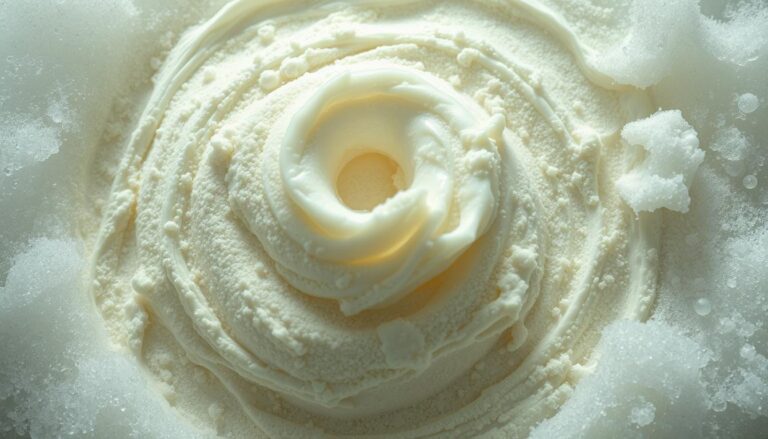Can a Broken Tooth Heal or Fix Itself Over Time?

In the United States, one in five adults has a cracked or broken tooth. This raises questions about our body’s ability to heal itself. Many ask: Can a broken tooth heal or fix itself over time?
Dental experts say that small cracks might get stronger with saliva’s minerals. But bigger breaks usually need quick dental care to avoid pain or infection. This article looks into how much teeth can heal themselves and what we can do to keep our teeth healthy.
Key Takeaways
- Minor cracks may remineralize if caught early
- Teeth have limited healing capabilities
- Deep damage often needs dental intervention
- Saliva contributes to enamel protection
- Timely exams boost long-term outcomes
- Understanding healing limits guides proper care
Understanding Tooth Anatomy
Teeth have layers that make them strong every day. Each part helps fight off cracks and helps heal when damage happens. This design helps us understand why some injuries cause pain or need more treatment.
Layers of a Tooth
Teeth have different parts to protect what’s inside. Enamel is the hard outer layer, dentin is softer but strong, and pulp is where nerves and blood vessels are. These parts work together to keep the tooth alive, but damage can hurt its function.
- Enamel resists daily grinding
- Dentin buffers external forces
- Pulp nourishes tooth structure
The Role of Enamel and Dentin
Enamel is hard and keeps acids and impacts out. But, if it cracks, dentin below can get hurt. Dentin is softer but important for feeling and keeping the tooth strong. This shows why fixing teeth quickly is so important.
Pulp and Nerve Functions
The pulp area is key for blood flow and nerve signals. Damage here can cause a lot of pain and increase infection risk. Quick treatment can help fix broken teeth and keep them healthy.
| Layer | Composition | Primary Function |
|---|---|---|
| Enamel | Hard mineralized surface | Shields the tooth from wear |
| Dentin | Semi-rigid substrate | Supports enamel and senses pressure |
| Pulp | Nerves and blood vessels | Sustains tooth vitality |
Types of Broken Teeth
Teeth can break in different ways, each with its own set of challenges. A cracked or fractured tooth might happen from biting hard things, facial injuries, or grinding teeth at night. Dentists use these types to figure out the best way to fix the tooth naturally and keep your mouth healthy.
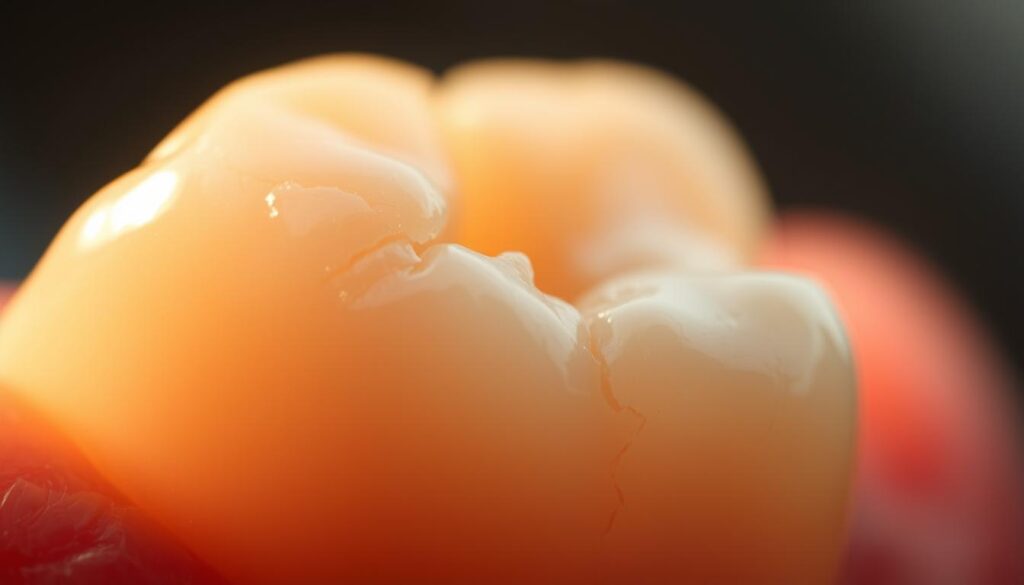
Cracked Teeth
Cracks show up as thin lines on the tooth. Some people only feel pain for a short time, while others feel sharp pain when eating. Catching it early can prevent more serious damage and help your tooth heal better.
Chipped Teeth
Chips usually happen at the edges of the tooth. They might look a bit off, but they can also be painful. A dentist will check it out and suggest ways to fix it, like bonding or smoothing.
Fractured Teeth
Fractures go deeper, into the dentin or pulp. This can make the tooth unstable and affect how it works. Dentists might need to use crowns, root canals, or other treatments to fix it naturally.
| Type | Key Features | Possible Solutions |
|---|---|---|
| Cracked | Hairline lines, intermittent pain | Bonding, crown placement |
| Chipped | Outer layer damage, cosmetic issue | Filling, smoothing, veneer |
| Fractured | Deeper layer involvement, structural risk | Root canal, crown, restorative care |
Common Causes of Tooth Damage
Teeth face daily wear and tear, but some actions can weaken them. Small cracks or weakened enamel often come from unnoticed habits. Dental experts watch for these signs to help teeth heal naturally.
Physical Trauma
Hard hits to the mouth or jaw can chip or crack teeth. Activities without mouthguards, falls, and blows can cause damage. The American Dental Association recommends wearing protective gear in sports to avoid harm.
Decay and Weakness
Ignoring cavities can weaken teeth. Bacteria can eat away at enamel, creating hidden weak spots. If not treated, small cracks can grow into bigger problems.
Aging Factors
Years of grinding and wear can thin enamel. This loss leaves teeth more vulnerable to fractures. Catching problems early can help keep teeth strong and functional, supporting the body’s healing abilities.
Initial Signs of a Broken Tooth
Spotting a broken tooth early is key to fixing it. The American Dental Association (ADA) says even small twinges or cracks can mean big problems. Ignoring these signs can lead to more pain and infections.
Sensitivity to Temperature
Drinking cold or warm drinks can hurt if your tooth is weak. If the pain lasts, it might mean your enamel is damaged. Getting your tooth checked is important to keep it strong.
Pain When Biting
Feeling pain when you bite can mean your tooth is under strain. This pain can get worse if you don’t see a dentist. Seeing a dentist quickly can help avoid bigger problems.
Visible Cracks or Chips
Seeing cracks or chips in your tooth is a warning sign. Finding these early helps fix your tooth before it gets worse. Your dentist might suggest bonding or crowns to fix it.
| Indicator | Recommended Action |
|---|---|
| Temperature Sensitivity | Consult dentist for comprehensive exam |
| Sharp Pain on Biting | Limit hard foods, schedule professional check |
| Noticeable Cracks or Chips | Seek early repair to prevent deeper damage |
Can a Broken Tooth Heal Naturally?
Teeth can try to fix themselves when they get a little hurt. This happens because of minerals in saliva that help make the enamel stronger. A small chip or crack might get better as the tooth heals.
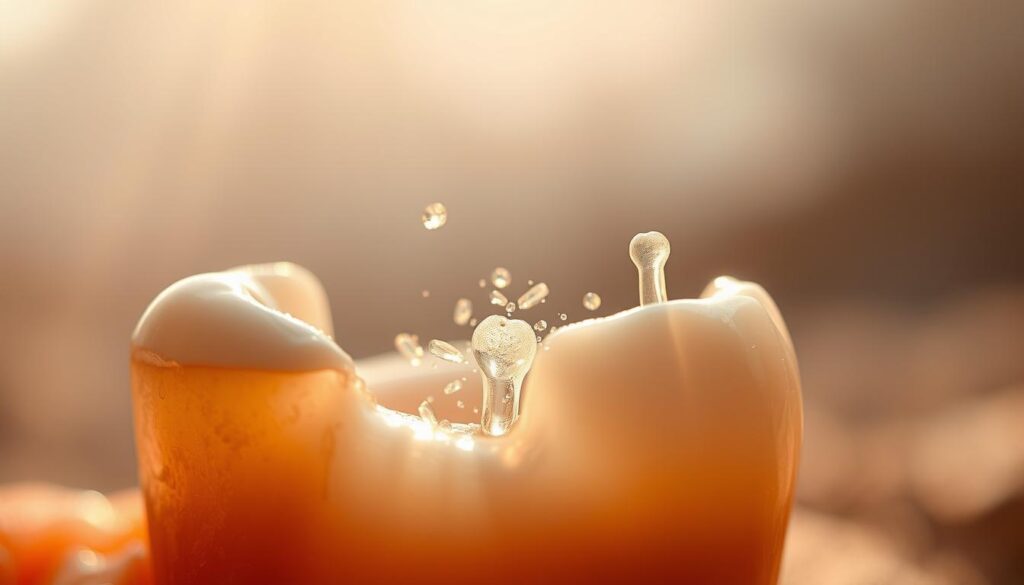
Self-repair Mechanisms of Teeth
Saliva has important minerals that can fill in tiny gaps. These minerals help make the enamel stronger. Small cracks on the outside might get better if they don’t get hurt again.
Limitations of Natural Healing
But, deeper layers of the tooth can’t always fix themselves. A small crack might get better, but bigger breaks need help. Taking care of your teeth can prevent bigger problems.
When Healing Is Not Possible
Some problems are too big for the body to fix:
- Pulp exposure leading to infection
- Fractures below the gum line
- Extensive enamel loss
Seeing a dentist is important for these issues. They can help keep your tooth working well and your mouth healthy.
The Role of Saliva in Healing
Saliva is a key protector in our mouths. It cleans away debris and bacteria that harm enamel. It keeps the mouth balanced, helping teeth repair themselves and fixing small damage before it gets worse.
Saliva’s Protective Properties
Saliva has special enzymes that fight off bacteria. These enzymes, along with saliva’s flow, prevent harmful buildup. It also brings minerals like calcium and phosphate to strengthen the tooth’s outer layer.
Remineralization Process
Remineralization is when enamel absorbs minerals. This can stop or slow down early damage. Keeping teeth strong needs a steady supply of these minerals.
Importance of Oral Hygiene
Good oral hygiene works with saliva to protect teeth. Brushing, flossing, and using fluoride helps keep minerals in. These habits fight plaque and keep pH levels healthy. Simple steps can help saliva do its job and prevent damage.
- Brush twice a day with fluoridated toothpaste
- Floss to remove interproximal debris
- Hydrate often to encourage proper salivary flow
| Mineral | Role in Enamel Preservation |
|---|---|
| Calcium | Strengthens tooth structure |
| Phosphate | Enhances remineralization and aids stability |
When to Seek Dental Help
Is a small crack in your tooth really no big deal? Or could it be a sign of something more serious? Even though some teeth can heal on their own, it’s rare. Tiny cracks can let bacteria in, causing infections.
Signs That Indicate Immediate Care
Do you feel pain that won’t go away? It might mean your tooth’s nerve is involved. Swelling quickly means there’s inflammation under the enamel. If your tooth bleeds or hurts a lot, you need to see a dentist fast. Ignoring these signs can make things worse.
The Importance of Regular Check-Ups
Dentists or hygienists can spot small cracks early. Regular visits help prevent bigger problems. Even small cracks can hide bigger issues like decay. Getting help early can save you from more complicated treatments.
Treatment Options Overview
Experts say to always check any tooth damage. Small chips might need a filling, while bigger cracks need crowns. In severe cases, you might need a root canal. While some hope for a tooth to heal itself, getting help quickly is usually safer.
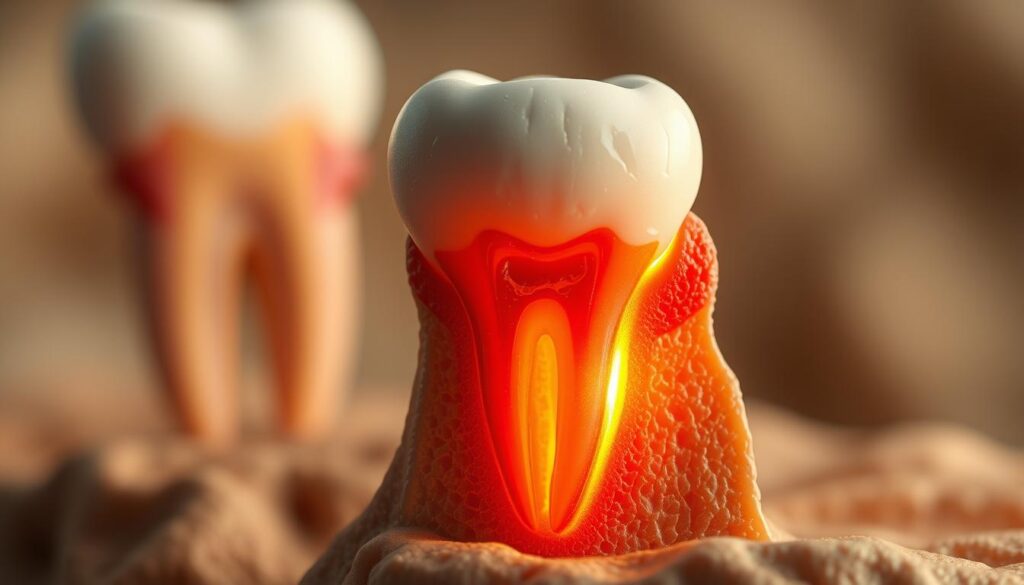
| Treatment | Purpose |
|---|---|
| Filling | Repair minor cracks |
| Crown | Protect compromised enamel |
| Root Canal | Eliminate infection and preserve structure |
Available Treatments for Broken Teeth
Dentists have many ways to fix chips, cracks, and serious damage. Small breaks can be fixed with special materials that make the tooth strong again. Bigger problems might need extra support or a protective layer.
Bonding and Filling
For small issues, bonding is a good choice. It uses a resin to build up the tooth. Fillings can seal cavities and protect the inside of the tooth.
Crowns and Veneers
Teeth that are badly damaged might need a crown. Veneers can fix the front of the tooth. Both help keep the tooth strong and looking good.
Root Canals
Damage to the pulp can cause pain and infections. A root canal removes the bad tissue. Then, the canal is sealed to prevent more problems. Sometimes, a crown is needed to keep the tooth working right.
- Strengthen compromised enamel
- Protect inner components
- Restore chewing ability
| Treatment | Benefit | Procedure | Outcome |
|---|---|---|---|
| Bonding | Fixes small chips | Composite resin application | Quick aesthetic repair |
| Crown | Guards weak structure | Custom-fitted cap | Long-lasting protection |
| Root Canal | Tackles pulp damage | Remove infected tissue | Relieves pain, salvages tooth |
Lifespan of a Broken Tooth
After fixing a broken tooth, it can last for years with the right care. Keeping up with dental check-ups and cleanings is key. Brushing and flossing daily helps prevent decay.
Materials that protect the tooth also play a big role. Taking care of your teeth helps keep the repair strong. This supports your overall dental health.
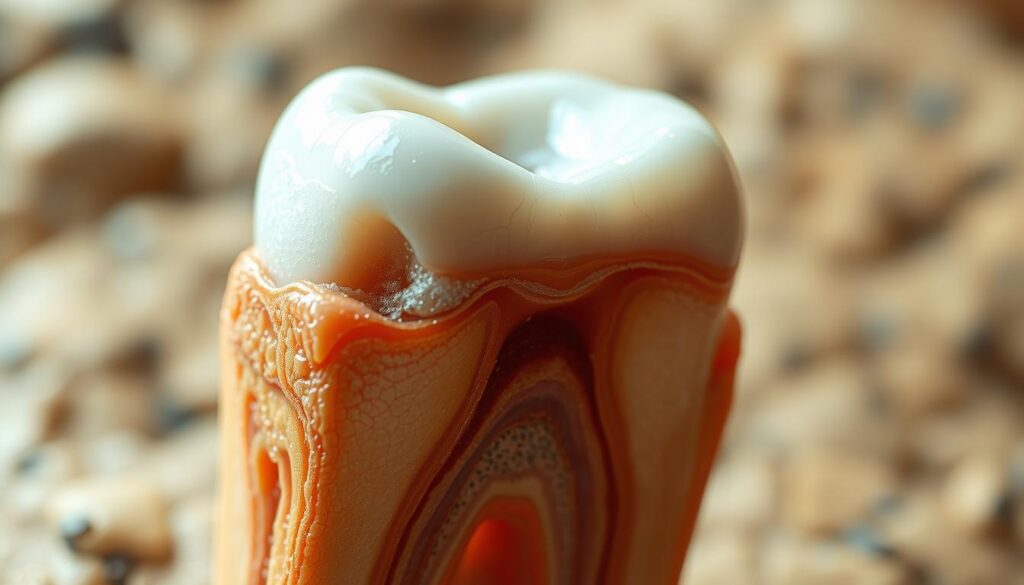
Factors Affecting Longevity
What you eat, how well you brush, and the quality of dental work matter. Missing cleanings or ignoring small problems can harm your tooth. This can make it last less time.
Potential Complications
Grinding or biting issues can cause small cracks and pain. If the tooth’s inside layers show, bacteria can cause infections. This can hurt the tooth’s function and look.
Preventive Measures
Here are ways to protect your fixed tooth:
- Use a mouthguard to reduce grinding stress
- Brush and floss well to fight bacteria
- Go for regular dental exams to catch problems early
These steps help your tooth stay healthy and strong for longer.
The Impact of a Broken Tooth on Oral Health
Why do dentists stress the need for quick action when a tooth cracks or breaks? If ignored, the damage can spread to other parts of the tooth. This makes deeper tissues more open to bacteria. The American Dental Association says acting fast helps avoid bigger problems and keeps teeth stable.
Risk of Infection
A broken tooth can let bacteria in. These germs can move into the pulp or even the jawbone, causing abscesses. This puts a lot of pressure on the immune system, making it hard for tissues to heal and increasing the risk of more decay.
Possible Misalignment
A broken tooth can change how teeth fit together. Neighboring teeth might move or tilt, upsetting the bite balance. This small change can put uneven stress on the jaw, leading to long-term joint problems.
Effects on Chewing
Even small cracks can make it hard to bite down. This forces you to avoid chewing on the painful area. It affects how you digest food, leading to less nutrient absorption and discomfort. The strain can also make the tooth problem worse, making it more urgent to fix.
Myths and Misconceptions About Broken Teeth
Many people think a small crack can wait before getting help. But, this delay can hide bigger problems that might get worse if ignored. We want to clear up common myths so you can act fast when your tooth gets damaged.
Do All Cracks Require Immediate Attention?
Some cracks don’t hurt right away, but tiny cracks can weaken the tooth inside. Dentists say to see them quickly to check for hidden damage. This early check can stop bigger problems later.
Can a Tooth Repair Itself Completely?
Natural healing helps the surface of the tooth, but big breaks need a dentist. Teeth can only fix small surface issues, not deep cracks.
Will a Broken Tooth Always Hurt?
Not always. A tooth might feel fine at first, but then hurt when nerves get exposed or infected. Knowing this helps you decide when to see a dentist.
| Common Misconception | Reality |
|---|---|
| Small Cracks Are Harmless | Minor flaws can conceal bigger structural issues |
| Teeth Heal Fully on Their Own | Deep fractures typically need clinical intervention |
| A Broken Tooth Always Causes Pain | Symptoms may remain mild until substantial damage forms |
Conclusion
Teeth can fix small chips on their own, but big breaks need a doctor’s help. Getting help fast is key to fixing a broken tooth. We aim to improve health with new treatments and learning more about healing teeth.
Recap of Healing Possibilities
Small cracks might heal naturally, but big breaks need bonding or crowns. Quick action keeps your teeth strong and healthy.
Final Thoughts on Dental Care
Knowing what to do helps fix problems better. A correct diagnosis helps everyone plan the best fix. Studies show early treatment cuts pain and keeps teeth strong.
Encouragement for Regular Dental Visits
Regular dental visits catch problems early. Experts say preventive care is crucial for comfort. Learning more about fixing teeth makes smiles stronger and health better.


